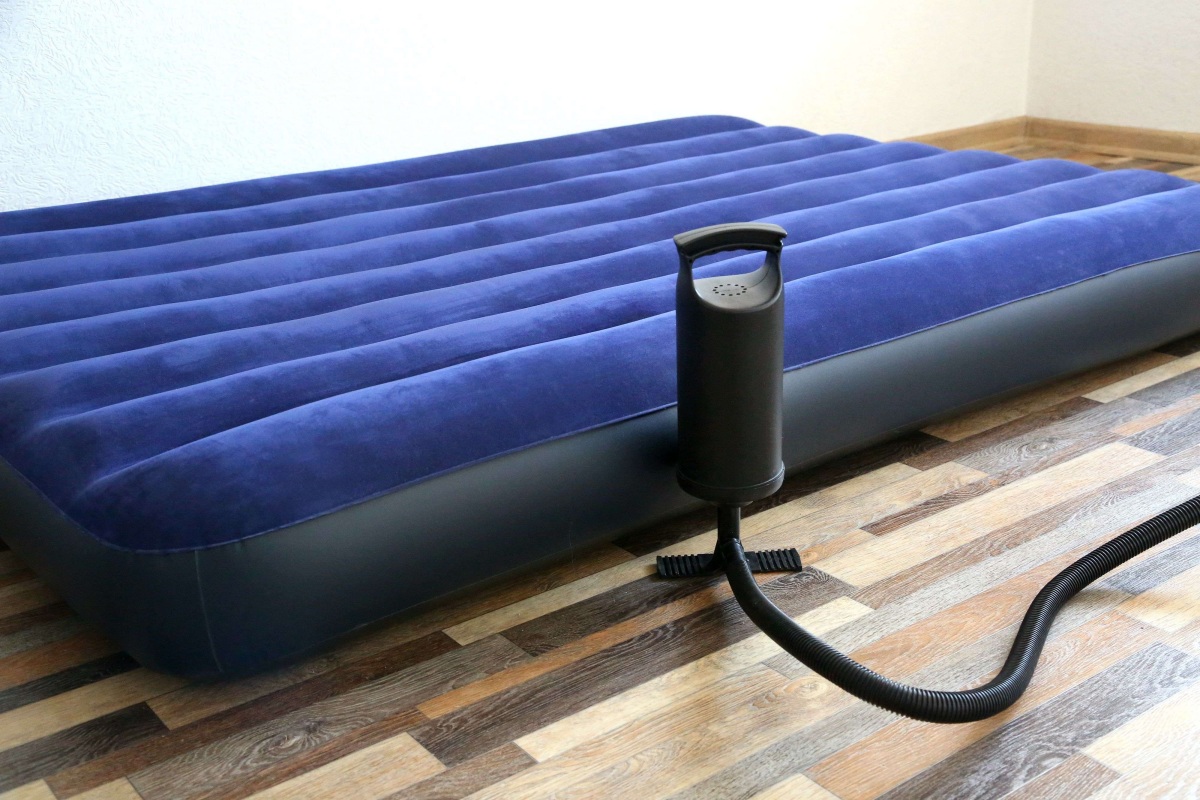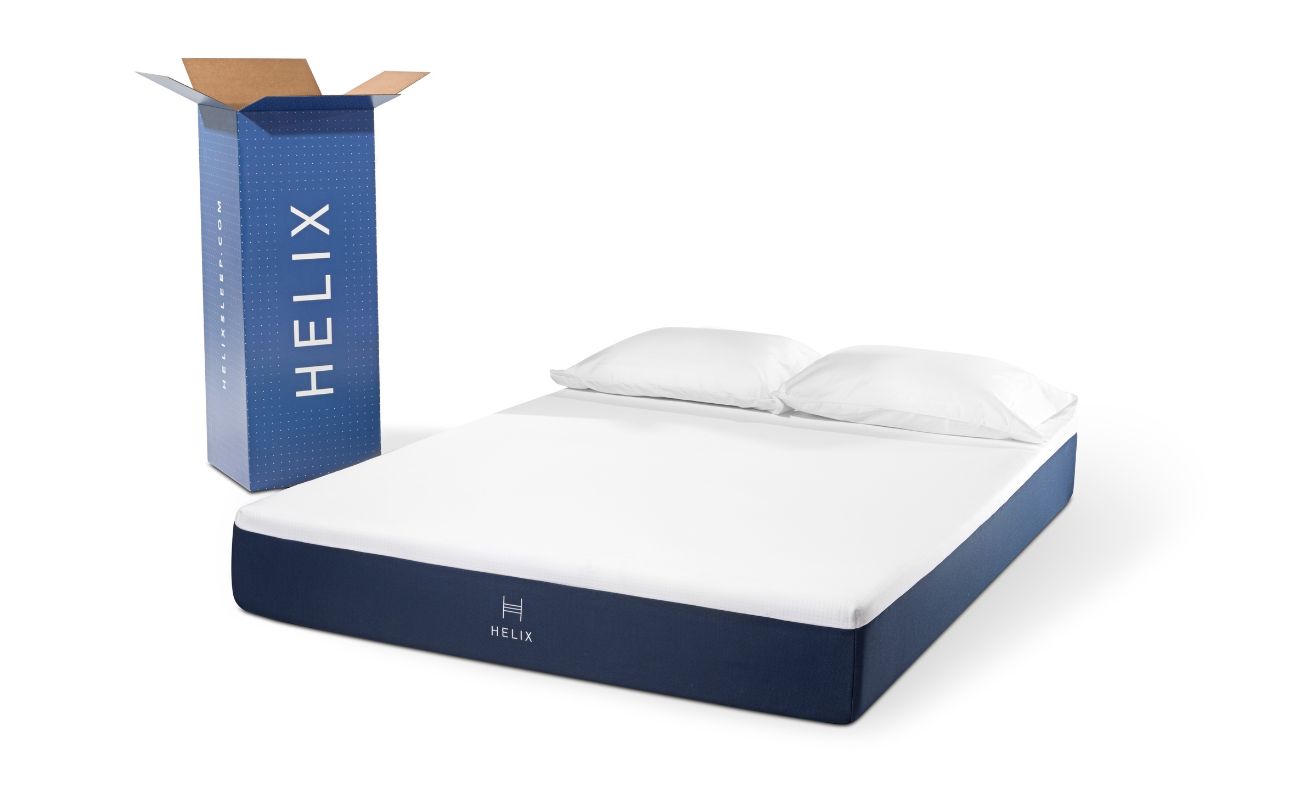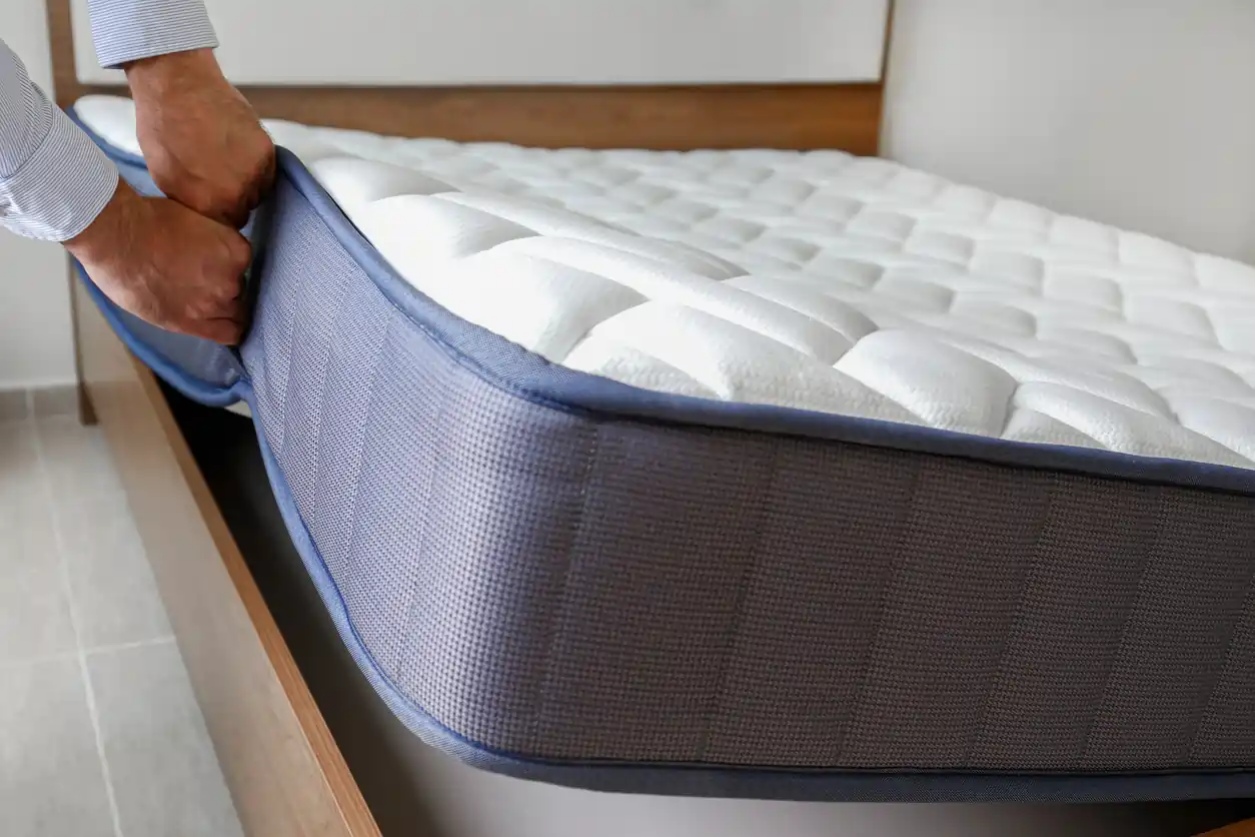Home>Furniture>Bedroom Furniture>How Long Does It Take To Adjust To A New Mattress


Bedroom Furniture
How Long Does It Take To Adjust To A New Mattress
Modified: March 6, 2024
Discover how long it takes to adjust to a new mattress and improve your sleep quality. Explore the best bedroom furniture options today.
(Many of the links in this article redirect to a specific reviewed product. Your purchase of these products through affiliate links helps to generate commission for Storables.com, at no extra cost. Learn more)
Introduction
Adjusting to a new mattress can be an exciting experience, but it may also require some patience and time. Your mattress plays a crucial role in the quality of your sleep and overall comfort, so it’s essential to give yourself the necessary adjustment period to fully reap the benefits of your new investment. In this article, we will explore the factors that can affect the time it takes to adjust to a new mattress.
Every individual’s adjustment period may vary based on factors such as the material type of the mattress, the firmness level, personal comfort preferences, and proper mattress maintenance. By understanding these factors and following some helpful tips, you can ease the transition and optimize your sleep experience on your new mattress.
So, let’s dive deeper into the factors that can influence how long it takes to adjust to a new mattress.
Key Takeaways:
- Give yourself time to adjust to a new mattress, as it can take a few days to a few weeks. Be patient and experiment with different sleeping positions for optimal comfort.
- Proper maintenance and gradual transition can help you adjust to a new mattress. Follow manufacturer guidelines, use pillows for support, and maintain a consistent sleep schedule for a smoother transition.
Factors Affecting Mattress Adjustment Time
The adjustment time for a new mattress can vary depending on several factors. Understanding these factors will give you a better idea of what to expect and help you manage your expectations during the transition period.
Material Type of Mattress: Different mattress materials have unique characteristics that can impact the adjustment time. For example, memory foam mattresses tend to have a longer adjustment period compared to innerspring or hybrid mattresses. This is because memory foam molds to your body, and it may take some time for your body to adapt to the new material.
Firmness Level: The firmness of your mattress can also affect the adjustment period. If you switch from a soft to a firm mattress or vice versa, it may take your body some time to get used to the new level of support. Generally, softer mattresses allow for more sinkage and contouring, while firmer mattresses provide more support.
Personal Comfort Preferences: Each person has unique comfort preferences when it comes to their mattress. If you were used to a certain type of mattress for a long time, switching to a different type may require a longer adjustment period. For example, if you were accustomed to a traditional innerspring mattress and switched to a foam or latex mattress, it may take time for you to adapt to the new feel.
Proper Mattress Maintenance: Taking care of your new mattress properly can also affect the adjustment time. If you follow the manufacturer’s guidelines for maintenance, such as rotating the mattress regularly or using a mattress protector, it can help prolong the lifespan of the mattress and ensure optimal comfort. A well-maintained mattress is more likely to provide consistent support and comfort throughout the adjustment period.
By considering these factors, you can manage your expectations and understand that the adjustment time may vary. It is essential to be patient and allow yourself enough time to adapt to the new mattress.
Material Type of Mattress and Adjustment Time
The material type of the mattress plays a significant role in how long it may take to adjust to a new mattress. Different materials have unique properties and characteristics that can affect the initial feel and comfort level. Let’s take a closer look at some common mattress materials and their adjustment periods.
1. Memory Foam Mattresses: Memory foam mattresses are known for their contouring and pressure-relieving properties. However, they can have a longer adjustment period compared to other mattress types. This is because memory foam responds to your body heat and weight, slowly conforming to your body’s shape over time. It may take a few weeks for your body to adapt and for the mattress to fully contour to your unique curves and sleeping patterns.
2. Innerspring Mattresses: Innerspring mattresses are constructed with a system of coils or springs, typically topped with a layer of cushioning material. These mattresses offer a more traditional and bouncy feel. Most people are already familiar with the sensation of sleeping on an innerspring mattress, so the adjustment period is generally shorter compared to other materials.
3. Latex Mattresses: Latex mattresses are made from natural or synthetic latex foam. They are known for their responsiveness, durability, and breathability. The adjustment period for latex mattresses is typically shorter compared to memory foam. However, it is essential to note that the firmness level of latex mattresses can vary, so it may still take some time for your body to adapt to the specific feel of the mattress.
4. Hybrid Mattresses: Hybrid mattresses combine different materials, such as memory foam, latex, and innerspring coils, to provide a balanced feel and optimal support. The adjustment period for hybrid mattresses can vary depending on the specific combination of materials used. It may take some time for your body to adjust to the unique blend of contouring foam and responsive coils.
It’s important to remember that everyone’s body is unique, and individual preferences may influence the adjustment period. Some people may adapt more quickly to a new mattress, while others may take a bit longer. It’s perfectly normal to experience some initial discomfort or unfamiliar sensations when transitioning to a different mattress material.
Patience is key during this adjustment period. Give yourself time to experiment with different sleeping positions and allow the mattress to conform to your body’s shape. With patience and persistence, you’ll soon find yourself enjoying more restful and rejuvenating sleep on your new mattress.
Firmness Level and Adjustment Period
The firmness level of a mattress is one of the key factors that can influence the adjustment period. Mattresses come in a range of firmness options, from plush to extra firm, and finding the right level of firmness that suits your preferences is essential for a good night’s sleep. However, switching to a different firmness level can require an adjustment period. Let’s explore how firmness level affects the adjustment time.
1. Soft Mattresses: Soft mattresses provide a plush and cushioned feel, allowing your body to sink into the mattress. If you’re used to a firmer mattress and switch to a softer one, it may take some time for your body to adjust to the increased sinkage and contouring. These mattresses can provide pressure relief and a “hugged” sensation, but if you’re not accustomed to this level of softness, it may initially feel strange. Give yourself a few weeks to adapt to the new feel before making any final judgments.
2. Medium-Firm Mattresses: Medium-firm mattresses strike a balance between support and contouring. They provide a supportive surface with a slight amount of sinkage. If you’re transitioning from a softer or firmer mattress to a medium-firm one, the adjustment period may be shorter. This firmness level is popular among a wide range of sleepers and can offer a good level of comfort and support for most individuals.
3. Firm Mattresses: Firm mattresses provide minimal sinkage and a more rigid surface. If you’re accustomed to a softer mattress and switch to a firm one, it may initially feel too stiff or lacking in comfort. It can take some time for your body to adapt to the increased support and alignment provided by a firm mattress. However, it’s important to note that firmness preferences are subjective, and some individuals may find immediate comfort on a firm mattress.
The adjustment period to a new firmness level can vary depending on your body’s sensitivity, sleeping position, and personal preferences. It’s worth noting that some mattresses may have adjustable firmness options, allowing you to customize the feel to your liking. In these cases, the adjustment period may be shorter as you can fine-tune the firmness level to suit your needs.
During the adjustment period, give your body time to adapt to the new firmness level. Experiment with different sleeping positions to find the most comfortable and supportive alignment. It’s also important to note that a mattress may feel different after the break-in period of a few weeks, as the materials settle and mold to your body shape.
Remember, everyone’s adjustment period can vary, and it’s essential to have patience and allow yourself enough time to determine if the firmness level is suitable for your comfort and support needs. If after the adjustment period you still find the mattress uncomfortable, you may consider exchanging it for a different firmness level or exploring other options that better align with your preferences.
It can take anywhere from a few days to a few weeks to fully adjust to a new mattress. Give your body time to get used to the new support and comfort levels before making a final judgment.
Personal Comfort Preferences and Adjustment Duration
When it comes to adjusting to a new mattress, personal comfort preferences play a crucial role in the duration of the adjustment period. Each individual has unique preferences for the feel and support of a mattress, and it may take some time to find the perfect balance that suits your needs. Let’s delve into how personal comfort preferences can influence the adjustment duration.
Sleeping Position: The way you sleep can greatly impact your comfort preferences. Different sleeping positions require varying levels of support and pressure relief. For example, side sleepers often prefer a mattress with more contouring to relieve pressure on the hips and shoulders, whereas back or stomach sleepers may opt for a firmer mattress to maintain proper spinal alignment. If your new mattress does not align with your preferred sleeping position, it may take time for your body to adjust to the new support and alignment.
Body Weight: Body weight can also influence mattress preference and adjustment time. Heavier individuals may prefer a firmer mattress to prevent excessive sinkage and maintain proper support. Lighter individuals may find a softer mattress more comfortable for enhanced conformity. Adjusting to a mattress that is different from what you have been accustomed to based on your body weight may require an adjustment period as your body acclimates to the new level of support or softness.
Specific Health Needs: Certain health conditions may require specific mattress features for optimal comfort and support. For example, individuals with back pain may benefit from a medium-firm mattress that provides adequate support while contouring to their body shape. Others with conditions like arthritis or fibromyalgia may find relief with a mattress that offers more cushioning and pressure relief. If your new mattress is specifically chosen to address your health needs, it may take some time for your body to adjust to the unique features and support provided by the mattress.
Previous Mattress Experience: Your previous mattress experience can also impact the adjustment period. If you were used to a particular mattress type or firmness level, transitioning to something different may require more time to get accustomed to the new feel. This is particularly true if your new mattress is a significant departure from what you’ve been sleeping on for a long time. Give yourself a proper adjustment period to allow your body to adapt to the different feel and support.
It’s important to recognize that personal comfort preferences are subjective, and what works for one person may not work for another. It may be helpful to consider mattress trials or return policies that allow you to test a new mattress for an extended period. This gives you the opportunity to fully evaluate its comfort and support and make a well-informed decision based on your personal preferences.
Remember, adjusting to a new mattress is a process, and it may take anywhere from a few days to a few weeks to adapt to the new feel. Be patient, give your body time to adjust, and pay attention to your comfort levels and sleep quality. If, after the adjustment period, you are still experiencing discomfort or dissatisfaction, it may be worth exploring other mattress options to ensure you have a restful and rejuvenating sleep experience.
Read more: How Long Does New Construction Take
Proper Mattress Maintenance and Adjustment Time
Proper maintenance of your new mattress can have a significant impact on the adjustment period and overall performance. Following the manufacturer’s guidelines for care and maintenance can help ensure that your mattress remains in optimal condition and provides consistent comfort and support. Let’s explore how proper mattress maintenance contributes to the adjustment time.
Break-in Period: Many mattresses, especially those made with foam or other contouring materials, have a break-in period. During this time, the mattress materials settle and conform to your body shape. It is common for a new mattress to feel different during the break-in period compared to the showroom or initial experience. This adjustment period can last anywhere from a few days to several weeks, depending on the specific mattress and materials used. It’s essential to allow your mattress this break-in period before making any final judgments on its comfort and support.
Rotation and Flipping: Some mattresses require regular rotation or flipping to promote even wear and prevent uneven sagging. This is especially true for two-sided mattresses or those with specific guidelines from the manufacturer. By following the recommended rotation or flipping schedule, you can help maintain the integrity of the mattress and ensure that it continues to provide consistent support and comfort over time. Failure to properly rotate or flip your mattress may lead to uneven wear, which can affect the adjustment period and overall lifespan of the mattress.
Use of Mattress Protectors: Using a mattress protector can help preserve the cleanliness and freshness of your new mattress. Mattress protectors create a barrier against spills, stains, dust mites, and allergens. By keeping your mattress clean and protected, you can extend its longevity and maintain a hygienic sleep environment. Additionally, a mattress protector can help with temperature regulation, moisture wicking, and reducing wear and tear on the mattress. A clean and well-protected mattress can contribute to a more comfortable adjustment period.
Proper Bedding and Pillows: The bedding and pillows you use can also impact the adjustment time to a new mattress. It’s important to ensure that your pillows and bedding are suitable for your comfort preferences and properly support your neck, shoulders, and body. The right combination of pillows, sheets, and blankets can enhance the overall sleep experience and help expedite the adjustment period by providing the right level of comfort and support.
By following the manufacturer’s guidelines for mattress maintenance and care, you can optimize the performance and comfort of your new mattress. Additionally, proper maintenance practices can help minimize any initial odors or off-gassing associated with new mattresses, ensuring a more pleasant sleeping environment from the start.
Remember, the adjustment period may still be necessary even with proper mattress maintenance. It’s important to be patient and give yourself enough time to adapt to the new feel and support. However, by properly maintaining your mattress, you can create an ideal sleeping environment that promotes a smoother and more comfortable adjustment period.
Tips to Help Adjust to a New Mattress
Adjusting to a new mattress can sometimes take time and patience. However, there are several tips you can follow to make the transition smoother and help you get the most out of your new investment. Here are some helpful tips to aid in adjusting to a new mattress:
1. Give It Time: Understand that adjusting to a new mattress is a process that can take anywhere from a few days to a few weeks. It’s important to be patient and allow your body to adapt to the new feel and support. Give yourself ample time to experience the full benefits of the mattress before making any final judgments.
2. Gradual Transition: If possible, consider gradually transitioning to the new mattress. For example, you can start by sleeping on the new mattress for a few hours each night and gradually increase the time until you are sleeping on it full-time. This gradual approach can help your body gradually adapt to the new feel and minimize potential discomfort during the adjustment period.
3. Experiment with Different Sleeping Positions: Try different sleeping positions to find the one that provides optimal comfort and support on your new mattress. Some mattresses may feel different depending on the sleeping position, so it’s worth exploring different options to find the position that works best for you.
4. Use Pillows for Additional Support: If you find that the new mattress lacks support or doesn’t align perfectly with your comfort preferences, experimenting with different pillows can help. Using pillows to provide additional support or cushioning in certain areas can help bridge any gaps and enhance your overall comfort on the new mattress.
5. Maintain a Consistent Sleep Schedule: Consistency in your sleep schedule can also facilitate the adjustment process. Stick to a regular sleep routine, including consistent bed and wake-up times, to help your body adapt more quickly to the new mattress. A consistent sleep schedule can promote better sleep quality and aid in the adjustment period.
6. Ensure Proper Bedding and Sleep Environment: Make sure that your bedding, including sheets and blankets, is suitable for your comfort preferences. Opt for breathable fabrics that promote airflow and temperature regulation. Additionally, create a sleep environment that is conducive to relaxation, with proper lighting, temperature control, and minimal distractions.
7. Communicate with the Manufacturer: If you’re experiencing persistent discomfort or issues with your new mattress, don’t hesitate to reach out to the manufacturer. They may have valuable insights or suggestions to help address your concerns. Some mattress companies also offer trial periods or return policies that allow you to exchange or return the mattress if you’re not satisfied after a certain period.
By following these tips, you can make the adjustment period more comfortable and manageable. Remember that every person’s experience may vary, and it’s important to listen to your body and make adjustments as needed. With time and patience, you’ll soon enjoy restful nights and wake up feeling refreshed on your new mattress.
Conclusion
Adjusting to a new mattress is a process that can vary in duration and comfort levels for each individual. Factors such as the material type of the mattress, firmness level, personal comfort preferences, and proper mattress maintenance all play a role in the adjustment period. It’s crucial to be patient and allow yourself enough time to adapt to the new mattress and find the perfect balance of support and comfort.
Understanding the material type of the mattress can provide insight into the potential adjustment time. Different materials, such as memory foam, innerspring, latex, and hybrid, have unique characteristics that can influence how your body responds to them. It’s essential to give your body time to adapt to the specific properties of the mattress material.
The firmness level of the mattress is another crucial factor in the adjustment process. Whether you prefer a soft, medium-firm, or firm mattress, transitioning to a different firmness level may require some time for your body to get accustomed to the new support and feel. Personal comfort preferences, including your preferred sleeping position, body weight, and specific health needs, also impact the adjustment duration to a new mattress.
Proper mattress maintenance can contribute to a smoother adjustment period. Following the manufacturer’s guidelines for maintenance, such as rotating the mattress, using a mattress protector, and ensuring proper bedding and pillows, can help maintain the mattress’s integrity and hygiene. A well-maintained mattress can provide consistent support and comfort throughout the adjustment period and beyond.
Tips such as giving yourself time, gradually transitioning to the new mattress, experimenting with different sleeping positions, and maintaining a consistent sleep schedule can further aid in the adjustment process. It’s also important to communicate with the manufacturer if you have persistent discomfort or issues to explore potential solutions or take advantage of trial periods or return policies.
In conclusion, adjusting to a new mattress is a personal journey that requires patience and attention to individual needs and preferences. By understanding the factors that influence the adjustment time, following proper mattress maintenance practices, and implementing helpful tips, you can ensure a more comfortable and enjoyable sleep experience on your new mattress. Remember, with time and perseverance, you’ll find yourself waking up refreshed and rejuvenated, fully adapted to your new mattress.
Frequently Asked Questions about How Long Does It Take To Adjust To A New Mattress
Was this page helpful?
At Storables.com, we guarantee accurate and reliable information. Our content, validated by Expert Board Contributors, is crafted following stringent Editorial Policies. We're committed to providing you with well-researched, expert-backed insights for all your informational needs.














